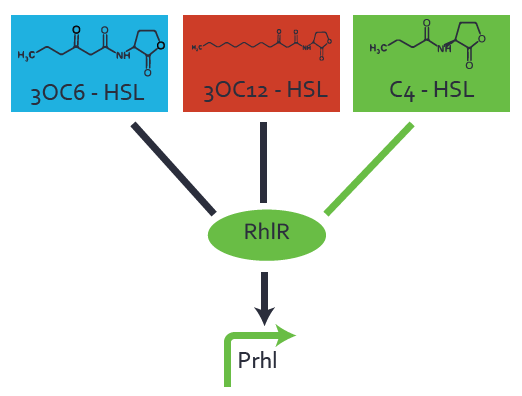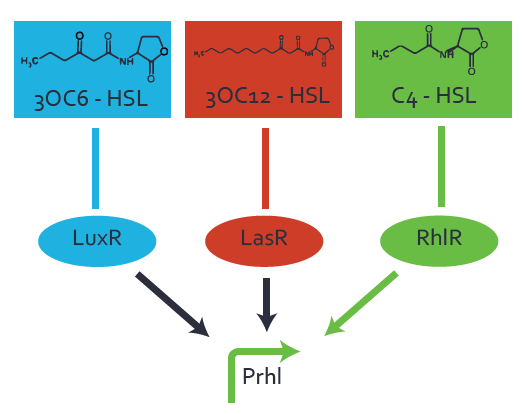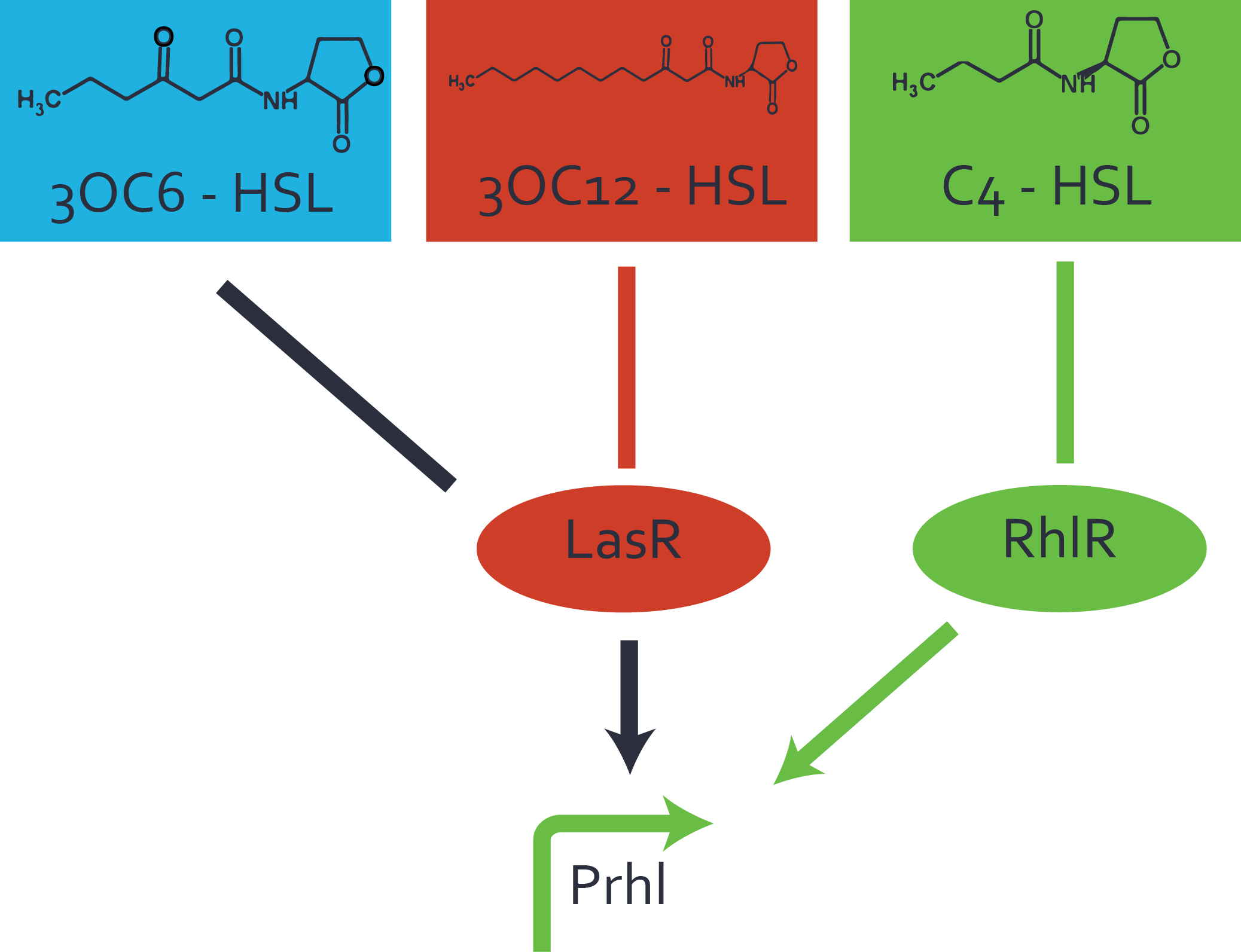Difference between revisions of "Part:BBa J10050:Experience"
| Line 33: | Line 33: | ||
[[File:ETH Zurich 2014 2nd order rhl.png|400px|thumb|center| '''Figure 3 Overview of possible crosstalk of the [https://parts.igem.org/Part:BBa_I14017 pRhl] promoter with both the regulator and inducer being unrelated to the promoter and each other.''' Usually, [https://parts.igem.org/Part:BBa_C0171 RhlR] together with inducer [[AHL|C4-HSL]] activate their corresponding promoter [https://parts.igem.org/Part:BBa_I14017 pRhl] (green). However, [https://parts.igem.org/Part:BBa_I14017 pRhl] may also be activated by another regulator together with an unrelated inducer. For example, the inducer [[3OC6HSL|3OC6-HSL]] (light blue) may interact with the [https://parts.igem.org/Part:BBa_C0179 LasR] regulator (red) and together activate [https://parts.igem.org/Part:BBa_I14017 pRhl] (green).]] | [[File:ETH Zurich 2014 2nd order rhl.png|400px|thumb|center| '''Figure 3 Overview of possible crosstalk of the [https://parts.igem.org/Part:BBa_I14017 pRhl] promoter with both the regulator and inducer being unrelated to the promoter and each other.''' Usually, [https://parts.igem.org/Part:BBa_C0171 RhlR] together with inducer [[AHL|C4-HSL]] activate their corresponding promoter [https://parts.igem.org/Part:BBa_I14017 pRhl] (green). However, [https://parts.igem.org/Part:BBa_I14017 pRhl] may also be activated by another regulator together with an unrelated inducer. For example, the inducer [[3OC6HSL|3OC6-HSL]] (light blue) may interact with the [https://parts.igem.org/Part:BBa_C0179 LasR] regulator (red) and together activate [https://parts.igem.org/Part:BBa_I14017 pRhl] (green).]] | ||
| − | |||
| − | |||
| − | |||
| − | |||
| − | |||
| − | |||
| − | |||
| − | |||
| − | |||
| − | |||
| − | |||
| − | |||
| − | |||
| − | |||
| − | |||
| − | |||
| − | |||
| − | |||
| − | |||
| − | |||
| − | |||
| − | |||
| − | |||
| − | |||
| − | |||
| − | |||
| − | |||
| − | |||
| − | |||
| − | |||
| − | |||
| − | |||
| − | |||
| − | |||
| − | |||
| − | |||
| − | |||
| − | |||
| − | |||
| − | |||
| − | |||
| − | |||
| − | |||
| − | |||
| − | |||
| − | |||
| − | |||
| − | |||
| − | |||
| − | |||
| − | |||
| − | |||
| − | |||
| − | |||
| − | |||
| − | |||
| − | |||
| − | |||
| − | |||
| − | |||
| − | |||
| − | |||
| − | |||
| − | |||
| − | |||
| − | |||
Revision as of 11:08, 21 October 2019
This experience page is provided so that any user may enter their experience using this part.
Please enter
how you used this part and how it worked out.
Applications of BBa_J10050
User Reviews
UNIQd8d900c319928a75-partinfo-00000000-QINU
|
••••
ETH Zurich 2014 |
Characterization of weak promoter (BBa_J23113) and weak RBS (BBa_B0031)Differences in promoter strength had more effect on enzymatic expression compared to differences in RBS strengths as evidenced in the graphs below. Lambert_GA 2019 had originally thought that BBa_J10050 would result in the least amount of expression out of the tested combinations, but this part, along with BBa_J10051 and BBa_J10052, all shared the lowest expression out of the combinations. This is due to the translation rate not being an important factor in the determination of expression of ONP; however, the promoter strength is a significant factor. In other words, expression values are significantly different with different promoters but not with different RBS strengths.  Figure 1 Overview of possible crosstalk of the RhlR/pRhl system with three different AHLs. Usually, C4-HSL binds to its corresponding regulator, RhlR, and activates the pRhl promoter (green). However, RhlR may also bind 3OC12-HSL (red) or 3OC6-HSL (light blue) and then unintentionally activate pRhl.  Figure 2 Overview of possible crosstalk of the RhlR/pRhl system with two additional regulators (LuxR and LasR). Usually, RhlR together with inducer C4-HSL activate their corresponding promoter pRhl (green). However, pRhl may also be activated by the LuxR regulator together with 3OC6-HSL (light blue) or by the LasR regulator together with 3OC12-HSL (red).  Figure 3 Overview of possible crosstalk of the pRhl promoter with both the regulator and inducer being unrelated to the promoter and each other. Usually, RhlR together with inducer C4-HSL activate their corresponding promoter pRhl (green). However, pRhl may also be activated by another regulator together with an unrelated inducer. For example, the inducer 3OC6-HSL (light blue) may interact with the LasR regulator (red) and together activate pRhl (green).
UNIQd8d900c319928a75-partinfo-00000003-QINU |
